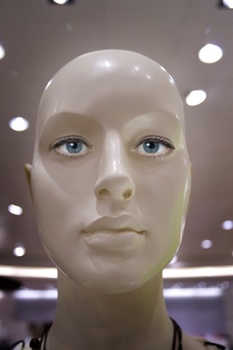When I conduct advertising seminars for business owners and ad agencies (usually sponsored by a local radio station or radio group), often the formal seminar is followed by a Client Hot Seat session. Business owners volunteer to sit onstage with me, one at a time, while I helped them identify their own Unique Selling Propositions.
A while ago, one of the volunteers owned a women’s apparel store. I asked what sets her store apart from her competitors.
“The two things I always talk about are service and selection,” she replied. “That’s what makes us different.”
Uh-oh. Every store says it’s got the best service and selection. And as a result, no one believes their commercials.
So I probed deeper, asking questions more or less at random until we discovered this store’s preemptive advantage.
DAN: Do you have competitors?
CLIENT: I would say our biggest competitor is the mall.
DAN: Why should someone come to your store to shop instead of at the mall?
CLIENT: Because we have service, we are easy to get to; you don’t have to haul yourself to the mall.
You can turn around in our store and not knock ten things off of a rack. We have qualified salespeople.
We have what I consider a really good selection.
The two things I always talk about are service and selection. That’s what makes us different.
DAN: The only problem with what you identify as the two things that make you different is that’s what all stores say.
All stores say, “What makes us different is our service and our selection.”
Now if you can prove this quantitatively — if you can say:
“If you go to the store at the mall to buy a bathing suit for this summer, you’re going to be stuck with the two choices they’ve already made for you. Because they only carry these two major brands that they can sell the most of, in limited styles and limited sizes. They sell a ton of them and they make a lot of money that way, however….If you come to OUR store, you’ll find 36 different kinds of bathing suits. We aren’t limited to those two manufacturers like the mall store is” —
— If you can quantify it. If you can truthfully say, “You might not know this, but according to Retailer’s Monthly Magazine the average women’s clothing store in a shopping mall has only X-number pieces of apparel, while our store has 4-times-X,” that can be powerful.
But everyone is going on the air or in print and saying, “We have a wide selection,” and nobody believes them.
And with Service, everyone says, “It’s our people who make the difference.” With the implication being, I guess, that their competitors don’t employ people; they employ robots or androids.
But if you are going to say, “Every one of our salespeople has passed an intensive, six-week course in Fashion,” then you can say:
“Who do you want helping you? Do you want the teenaged girl with the safety pin through her nose working after school at the mall, or do you want one of our Fashion Consultants whom we sent to Chicago for a six-week course at the Design Center where they learned about color and fabric and how to flatter someone’s face and how to work with a mature woman’s figure?”
That’s a great selling point. But when you say it’s your salespeople who are different, is there anything that objectively separates them from your competitors’?
CLIENT: Yes, because I spend a lot of time making sure they’re knowledgeable about their product.
DAN: How do you do that?
CLIENT: Because I’m there.
DAN: But what is it you do to make sure they’re knowledgeable about their product?
CLIENT: I talk to them.
DAN: Do you quiz them?
CLIENT: No. But I make them active in decision-making. They see the product from the minute in comes in the back door to the minute it’s hanging on the rack. They work on the floor.
DAN: Now this is interesting. What happens when the product comes in the back door?
CLIENT: They open the box and they hang it up.
DAN: Is there discussion? Do they talk about where it’s going to go or who they expect to buy it?
CLIENT: Yes, all of those things.
DAN: What kinds of things do they say?
CLIENT: (Laughing) Depending on whether they like it or not?
DAN: Sure!
CLIENT: “Isn’t this cute?”
“Oh, that’s a really pretty color.”
“I wonder if this matches that other item that we already have on the floor.”
“Oh, I should call Suzy Smith; she’ll love this.”
“Can I order one for myself?” (That’s a common one.)
DAN: At the big stores at the mall, are the sales clerks there when the big boxes are unloaded?
CLIENT: No.
DAN: Are the salespeople there when the clothing is put on display?
CLIENT: It comes in on rolling racks; I don’t know who puts it out on the floor.
DAN: Now this could be something different, a terrific commercial in which we hear — literally record the room when a new shipment comes in and we tell your staff, “Look, we’re recording this, but just forget about us and go ahead and have fun.”
I think it would be a wonderful commercial if we hear the salespeople. Your salespeople are mature women, matching your customer base?
CLIENT: Yes.
DAN: So we hear these women joyfully greeting the truck — “Oh, at last! I thought you’d never get here!”
“Sign here.”
And then the boxes are unloaded from the truck, and we hear them ripping open the boxes:
“Oh, this is beautiful!”
“You know, we have a yellow frock in the front window. We should put these two together; this would really go well with it.”
“You know who would like this? Suzy Smith. She comes in every few months, and she always says if we ever get something with daisies on it, we should tell her.”
That could be edited into a commercial.
You can say, “In a typical clothing store in a big shopping mall, the sales clerk first sees the dress at the same time the customer does. But at our store, here’s how it happens….”
I think what you’ve just described is wonderful. I didn’t know that’s what happens when the merchandise first arrives at a boutique, and I’ll best most consumers don’t know that either. That’s great.
You can say, “This is how it is at our store. If you want, you go can to the big department store at the mall and you’ll get a different high school girl every time, and if you can get her attention between texting her friends to ask her a question she’ll say, ‘I don’t know; I think they’re in back’…Or you can come here.”
That’s a great commercial.
And maybe when they go through the new arrivals, they won’t like something. Maybe they’ll say, “Who would wear that??”
CLIENT: No, their favorite phrase is, “Who bought this??” And that would be me, because I do all the buying!
DAN: There are so many different things you can do here. This could be part of a running gag:
“Oh, this is beautiful…Oh, I want this one for myself.”
And then at the end, “Let’s see what’s in this last box.”
And there’s a long pause, and then: “Who buys this???”
And then you come in and say, “Hi, I’m So-And-So, I buy it! I buy all the clothes here. I think everything I buy is great; my staff usually agrees with me. Why don’t you come and see what you like the most?”
In fact, you could have a “Who Buys This??” Special of the Week:
“Who buys this?? Who wants to wear a green pantsuit?””
And then you say, “Well, my staff thinks I’m crazy. But we got a great deal on it, I love the fabric, it will be very cool for summer. Come down to our store; we have it on display. Cast your vote: Should we send it back?”
It becomes an interactive aspect of your advertising. Anyone who hears that commercial and comes to your store will be sure to look at that green pantsuit. They’ll want to know if you’re crazy or if your staff is crazy.
You could hand out buttons to the staff that say, “WHO BUYS THIS??”
But even if the process you described of what happens when the merchandise first arrives is typical of what happens at small clothing shops everywhere, your customers don’t know that. And sharing this with them in your advertising will set you apart in their minds.


